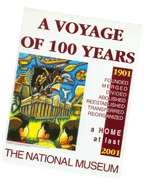ADMINISTRATIVE DIVISION

Function
Support various divisions of the National Museum by implementing the indispensable mechanisms in financial matters, personnel matters, and to ensure that efficient operations are compliant with government standard operating procedures.
Historical Notes
The operational efficiency of the 11 divisions of the National Museum rests heavily on the support system provided by the Administrative Division. It is likened to a human heart that pumps blood that flows through all the organs and muscles of the body to make it work.
In the early years, the administrative functions of the Museum were performed by the different personnel-scientists. Unfortunately these hampered the productivity of the technical groups, especially when the agency was still in the growing stage.
After many years, the government finally took notice of the difficult situation besetting the core divisions. In the 1960s, the Division was placed under the management and control of the Office of the Director with Mrs. Eustacia Enriquez as Head. By this time, the National Museum had about 68 personnel in its employ.
In a continuing move to improve the support machinery of the agency, a series of major reorganizations took place in 1962, 1968 and 1987 that Ied to the creation of more line and staff positions. The Accounting, Budget, Cashier, Personnel, Records, and Supply units were converted into sections.
Through the years, the Administrative Division has been constantly struggling against budget limitations. Modest resources were obtained basically from the national government through annual general appropriations as well as from the earnings of the agency.
Although the scarcity of resources was generally perceived as a major operational setback, it did not prevent Museum personnel from pursuing their sworn duties as defenders of our cultural and natural heritage. The Division managed to arrange participation in local trainings and seminars designed to continually improve and enhance personnel skills and performance. Most of these trainings were conducted by other government agencies such as the DOST, DECS, DOT, etc.
Meanwhile, key officers from various divisions of the National Museum secured technical assistance from their foreign counterparts in order to develop their scientific exposure.
Turning Points
The National Museum started to receive donations and grants from various government agencies and private institutions here and abroad in the 1970s. This development helped relax the tight financial posture of the agency. With the growing number of employees, fund appropriations from the national government were necessarily increased, although gradually.
The reorganization of 1987 was perhaps the most exciting experience of the Administrative Division. The new government of President Corazon C. Aquino brought about a feeling of renewed hope for the people of the National Museum, in anticipation of more plantilla positions, more funds, and more benefits.
With the appointment of Fr. Gabriel Casal as new Director of the Agency in 1987, a number of administrative reforms in favor of the employees were made. Salaries were raised, making them comparable with the salary scale of those in the private sector. Employee benefits were also improved. Developmental and skills trainings became more frequent and agency efficiency was enhanced with the procurement of additional computers and other office machines.
The euphoria did not end there. The financial assistance and grants that were received in the 1970s had evolved into bigger and more expensive projects towards the end of the 1980s up to the present, in collaboration with local and international organizations. In the last' few years, foreign institutions such as Mac Arthur Foundation, Ford Foundation, World Heritage Monument Fund, and many others have been generously funding the research and development efforts of Museum staff, and have even included the conduct of technical trainings and . scholarship or fellowship grants and purchase of equipment. The National Museum's need for funding from the national government was alleviated as large grants and donations poured in. Director Casal and the Administrative Division were highly instrumental in helping realize these achievements.
A Broader Role
The Administrative Division plays a very important role in the efficient functioning of alI the specialized divisions of the National Museum. It is charged with the tasks of providing adequate security, maintaining cleanliness and sanitation, mobility, safekeeping of records, provision of funds, supplies and equipment. Its most important role, therefore, is to serve as a most effective support mechanism for the entire agency, focusing on personnel development, budget and financial management, safety and security, supplies and other administrative matters.
Even as the years turn into decades and centuries, the Administrative Division will continue to be the heart of the National Museum, the heart that gives life to the Institution and nourishment to its people.
taken from the
"A Voyage of 100 Years"



